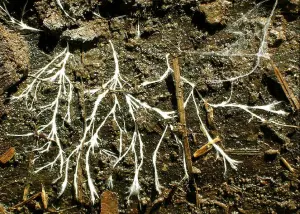 If you are a plant-brained type, or more accurately a fungaholic, you’ve no doubt heard of Paul Stamets’ book, Mycelium Running. It’s about the amazing and awe-inspiring powers of the little ol’ mycelium, those underground thread like ‘shrooms. As his subtitle suggests, How Mushrooms Can Help Save the World mushrooms can be used for everything from building houses to fuel to cleaning toxic waste up from the soil, not to mention our bodies.
If you are a plant-brained type, or more accurately a fungaholic, you’ve no doubt heard of Paul Stamets’ book, Mycelium Running. It’s about the amazing and awe-inspiring powers of the little ol’ mycelium, those underground thread like ‘shrooms. As his subtitle suggests, How Mushrooms Can Help Save the World mushrooms can be used for everything from building houses to fuel to cleaning toxic waste up from the soil, not to mention our bodies.
Once thought to have a sycophantic relationship with other plants, fungi got a bad rap. But numerous studies have shown that they have a symbiotic (mutually beneficial, can’t we all just get along?) relationship that those fungi seek out. The fungus gets carbon from the plant, and the network they form through the soil helps the plants draw nutrients from a wider area. Plus they help compost. But that is not all, no, that is not all…
A recent study had revealed that they actually act as underground transmitters when a plant is in distress. That’s right, they herald the cry of war in the deep, dark, dank underground.
Researchers at the University of Aberdeen in Scotland used five bean plants. Three were planted together, and the mycelium were allowed to grow between them in their usual fashion. The other two plants were planted together but inhibited from having mycelium in their soil. And then they botanist unleashed the hounds on them. Well, they unleashed aphids which is the rotany equivalent.
The plant that was attacked by aphids began emitting chemicals that help to attract wasps, something that many plants do when in distress. And while this is amazing enough, it’s hardly news. But this is: the plants that were connected via underground mycelium began also to produce the “distress” chemicals. But when aphids were released on the mycelium-free plant, it’s neighbor did not produce chemicals.
Previously, botanists believed that this chemical transmission was via the air from plant to plant. This astounding discovery means that the plants were using the mycelium to communicate. That’s right, folks, there is an entire underground network of mycelium and they are communicating from plant to plant, fungi to fungi.
The findings could turn the tides significantly on how to control pests without chemicals. Most food crops–such as wheat, maize, rice, beans including soy, and barley support a symbiotic fungi.
According to one of the study’s authors, Professor John Pickett of Rothamsted Research:
In a field of plants that have some inducible resistance to aphids, we could use a plant that’s susceptible to aphid attack to ‘switch on’ the defence mechanism through the natural underground connection. Aphids affect all higher-latitude agricultural regions, including the UK, the EU, North America, and North East Asia and there’s the potential to deal with other pests and diseases, in other regions, in a similar way.
Fungus are unique and classified in their own kingdom (The Kingdom of Fungi!!) because of the cell walls which contain chitin. Animal cells also contain chitin, but plant cells cellulose. Coulld you say they are half-plant, half-human. Almost. In truth, they fit neither group and so are their own kingdom, though generally considered the domain of botanists. (Mycologists and botanists certainly have a symbiotic relationship!)
Roots of nearly all groups of plants have symbiotic fungi.
Never underestimate the power of a mushroom. Stamets doesn’t. And Smurfs don’t.

 If you are a plant-brained type, or more accurately a fungaholic, you’ve no doubt heard of Paul Stamets’ book,
If you are a plant-brained type, or more accurately a fungaholic, you’ve no doubt heard of Paul Stamets’ book,